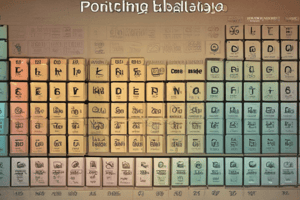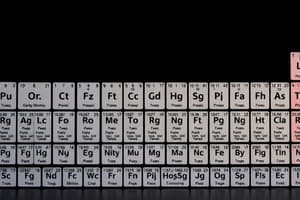Podcast
Questions and Answers
What is the primary arrangement factor for elements in the periodic table?
What is the primary arrangement factor for elements in the periodic table?
- Atomic weight
- Alphabetical order by element name
- Atomic number (correct)
- Physical state at room temperature
What characteristic is primarily used to group elements on the periodic table?
What characteristic is primarily used to group elements on the periodic table?
- Chemical reactivity (correct)
- Physical density
- Electronegativity
- Atomic radius
What is one of the element categories by color-coding in a typical periodic table?
What is one of the element categories by color-coding in a typical periodic table?
- Metals, nonmetals, metalloids (correct)
- Naturally occurring and synthetic elements
- Reactive and inert elements
- Gasses, solids, liquids
Besides atomic number, what other property of elements is typically displayed in the periodic table?
Besides atomic number, what other property of elements is typically displayed in the periodic table?
What are the vertical columns in the periodic table referred to?
What are the vertical columns in the periodic table referred to?
Flashcards
What is the basis of the periodic table?
What is the basis of the periodic table?
The periodic table organizes elements based on their atomic number, which is the number of protons in the atom's nucleus.
What are the characteristics of metals?
What are the characteristics of metals?
Metals are shiny, good conductors of heat and electricity, and malleable and ductile, meaning they can be shaped and stretched.
What are the characteristics of nonmetals?
What are the characteristics of nonmetals?
Nonmetals are often dull, poor conductors of heat and electricity, and brittle, meaning they break easily.
What makes metalloids unique?
What makes metalloids unique?
Signup and view all the flashcards
What are groups on the periodic table?
What are groups on the periodic table?
Signup and view all the flashcards
Study Notes
Periodic Table of Elements
- The periodic table arranges elements by atomic number and recurring chemical properties.
- Elements are organized into rows called periods and columns called groups.
- Elements in the same group share similar chemical properties.
- Each element is represented by a unique chemical symbol, such as Fe for iron.
- Atomic number indicates the number of protons in an atom's nucleus.
- Atomic mass is the total mass of protons and neutrons in an atom.
- Elements are color-coded based on their properties and categories, like metals, nonmetals, and metalloids.
- The table provides a visual representation of the relationships between elements.
- The table helps predict the properties of unknown elements.
- The periodic table is a fundamental tool in chemistry.
Studying That Suits You
Use AI to generate personalized quizzes and flashcards to suit your learning preferences.




